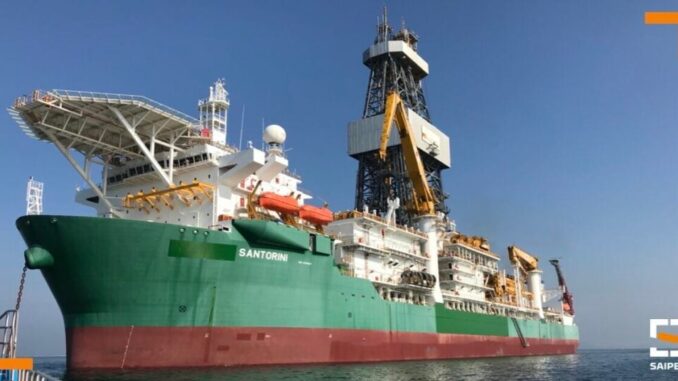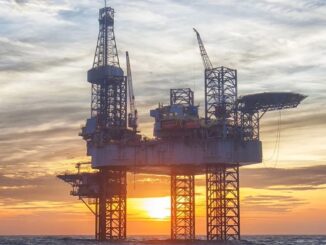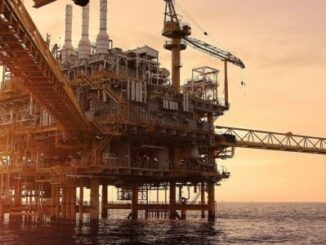
Home Fossil Energy Offshore drilling upcycle whets contractors’ appetite for rig reactivation with scrapping taking a downturn
Westwood Global Energy, an energy market research and consultancy firm, has revealed that offshore rig scrapping is at its lowest level in years, as the offshore drilling market’s recovery intensifies. As a result, cold-stacked rigs are being increasingly reactivated for new assignments amid growing demand and elevated day rates.
Santorini drillship; Source: Saipem
According to Westwood’s analysis, during the deepest period of the rig market downturn from 2014 to 2018, there was a yearly average of 43 rigs (jack-ups, semi-submersibles and drillships) permanently removed from the active fleet, mostly through scrapping or conversion for non-drilling purposes. During that time, the demand was 8 per cent lower – 549 rigs versus 505 – than the previous five-year average, spurring rig owners to rethink the size and quality of their fleets.
After the commodity prices and rig demand began to show signs of improvement during 2019, a 21 per cent drop in attrition was recorded compared to the 2014-2018 period. Westwood highlights that this was attributed to drilling contractors seeing the early signs of potentially putting assets, some of which had previously been circling the drain, back to work should demand and day rates rise sufficiently.
However, the 2019 market recovery was short-lived, as in 2020 the coronavirus pandemic obliterated rig demand and with it came a 35 per cent jump in rig attrition against the previous year, according to Teresa Wilkie, Westwood Director – RigLogix. The average age of rigs being retired fell to an all-time low between 2020 and 2021 and drillships as young as eight years old were being removed from the active fleet.
As another rig market upcycle, which took hold in the latter half of 2021, is currently ongoing, higher demand and utilisation are now being recorded in all three offshore drilling rig segments. Westwood believes that this is one of the main reasons behind the substantially lower level of attrition last year, as no drillships were removed from the active fleet in 2022, while just nine jack-ups and six semi-subs were retired, the majority of which were over 30 years old.
Furthermore, the company points out that rig owners are hanging on to vintage or cold-stacked tonnage, as is generally the case in a rising rig demand and day rate market, but the available supply of active, non-cold stacked rigs, especially jack-ups and drillships, is shrinking fast and there has already been word that several rigs, which have been idle for multiple years, are being bid into tenders where rig owners do not have any active rigs to bid.
Moreover, Westwood explains that the price tag associated with putting such a rig back to work these days is not cheap, with some drillers estimating this to be as much as $100 million for a drillship, which would often require a multi-year contract with a day rate high enough to make a suitable return. In addition, a driller may have to wait as long as 18 months for reactivation to be completed these days.
Reactivations of idle rigs become the teacher’s pet
With the tightening of the supply/demand balance, Westwood underscores that the reactivation of rigs has been on the rise with approximately 25 jack-ups, three semi-subs and nine drillships brought back to life since 2021. On the other hand, the level of newbuilds being delivered from shipyards has not increased to the same level witnessed during the short-lived 2019 recovery period.
Westwood further elaborates that 25 new jack-ups, four semi-subs and two drillships were delivered from shipyards in the Far East or Singapore during 2019, but 2022 brought with it just 10 deliveries in total, which is even less than the number delivered during 2020 (11 rigs).
Based on Westwood’s analysis, most of the remaining stranded newbuild rigs available, including 22 jack-ups, 15 drillships and eight semi-subs, are owned by the shipyards and drilling contractors continue to be very cautious when it comes to purchasing such a rig.
The company underlines that 2023 could be the year when the tide turns on this, especially if the level of demand continues to improve. This is illustrated by Transocean, which announced in the last quarter of 2022 that it had signed a purchase agreement as part of a joint venture for the seventh-generation ex-West Aquila drillship for $200 million from the Daewoo shipyard.
Meanwhile, Saipem confirmed it had exercised its option to buy the seventh-generation Santorini drillship (originally ordered by Ocean Rig), which it had been bare-boat chartering from Samsung Heavy Industries since 2021. Additionally, various drilling contractors are eyeing the remaining drillships left in yards.
Westwood claims that the level of new rig construction contracts being awarded has all but stopped, with just two new rigs ordered since 2015. The firm says that the industry’s sentiment indicates there is little appetite for new rigs to be ordered, following “the harsh lessons learned from previous newbuild cycles as well as a lack of spare capital for such an expensive purchase.”
Therefore, Westwood concludes that a wave of new construction is unlikely to be seen anytime soon and instead drilling contractors will look to their own idle fleets or already under-construction or stranded units to meet their clients’ needs if the current supply runs out.



